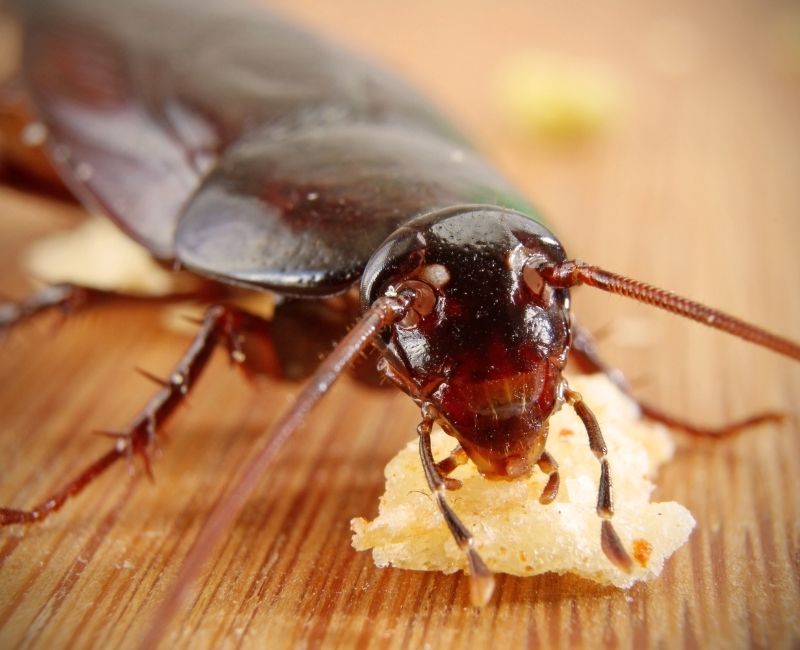Australian Cockroaches – Everything You Need to Know
Cockroaches are among the most persistent pests in Australia, thriving in warm, humid environments. While they are often associated with unclean spaces, even well-maintained homes can experience infestations.
Not all cockroach species behave the same way. Some, like the Australian cockroach, prefer outdoor habitats but occasionally enter homes. Others, such as the German cockroach, are indoor pests that breed rapidly and are harder to eliminate. Identifying the type of cockroach is essential for effective control.
Cockroaches are more than just a nuisance—they spread bacteria, contaminate food, and trigger allergies. Understanding their habits, breeding patterns, and preferred environments can help prevent infestations before they take hold. By implementing targeted prevention strategies and knowing when to seek professional pest control, homeowners and businesses can keep cockroach populations under control.
This guide covers the most common cockroach species in Australia, their risks, and the best methods to prevent and eliminate them.
Enquire Now
Key Facts About the Australian Cockroach
Scientific Classification:
- Kingdom: Animalia
- Phylum: Arthropoda
- Class: Insecta
- Order: Blattodea
- Family: Blattidae
- Genus: Periplaneta
Although the Australian cockroach prefers outdoor areas, it is commonly found in garages, sheds, and under decks. During summer, they may enter homes searching for food and moisture.
Common Types of Cockroaches in Australia
Australia is home to several cockroach species, each with different behaviors and preferred environments. Some infest homes and businesses, while others live outdoors but occasionally venture inside. Knowing which type you're dealing with is essential for effective control.
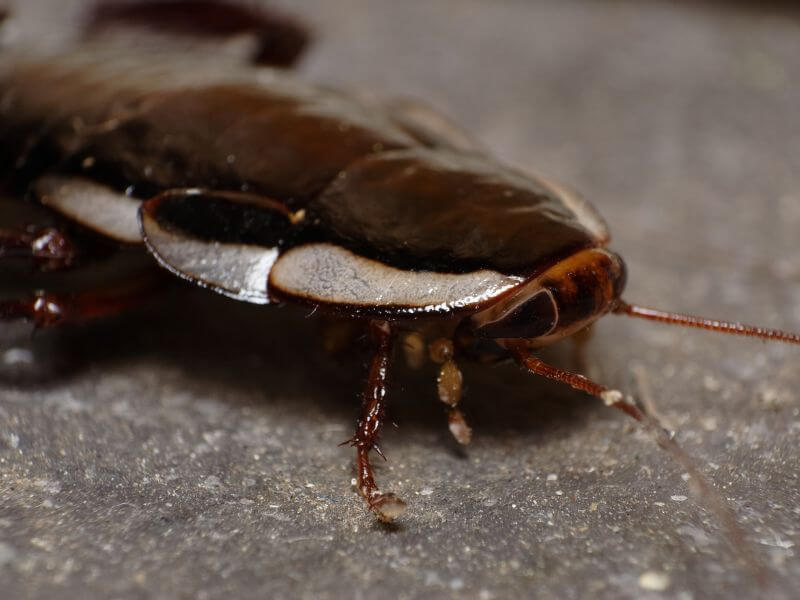
1. Australian Cockroach (Periplaneta australasiae)
- Size: 23–35 mm
- Habitat: Mostly outdoors, but enters homes during warm weather
- Key Features: Brown with a yellow margin on its pronotum and lighter wing markings
- Behavior: Often mistaken for the American cockroach, but prefers gardens, sheds, and wood piles. It may invade homes in search of food and moisture.
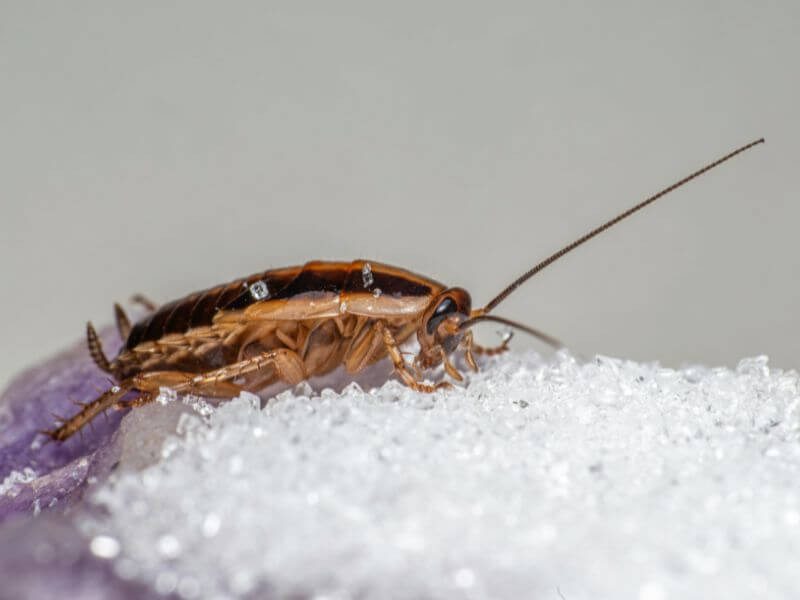
2. German Cockroach (Blattella germanica)
- Size: 10–15 mm (smallest common species)
- Habitat: Strictly indoors—kitchens, bathrooms, restaurants, and warm, humid areas
- Key Features: Light brown with two dark stripes running down its pronotum
- Behavior: Fast breeders—a single female can produce thousands of offspring in a year, making infestations difficult to control.
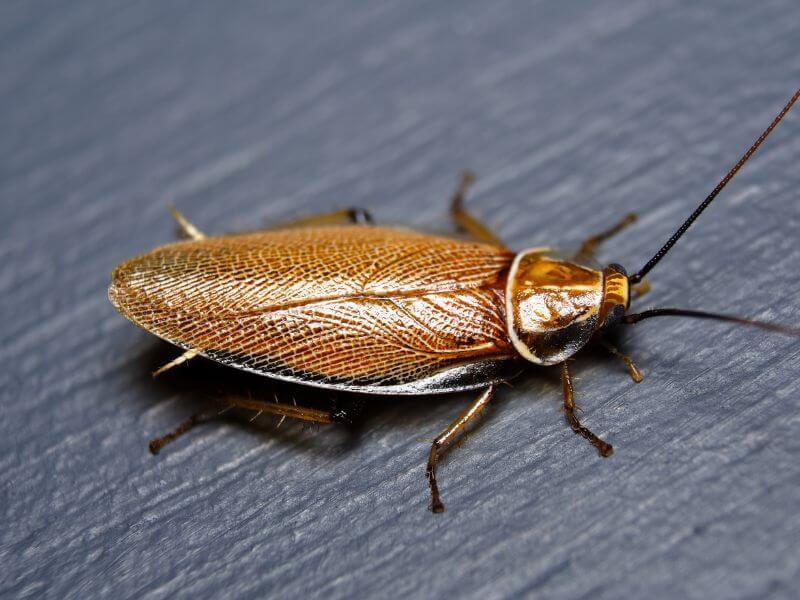
3. American Cockroach (Periplaneta americana)
- Size: 35–50 mm (largest household cockroach)
- Habitat: Drains, sewers, basements, and dark, damp areas
- Key Features: Reddish-brown with a pale yellow band behind its head
- Behavior: Lives in warm, moist environments and is commonly found in commercial buildings, particularly food storage areas.
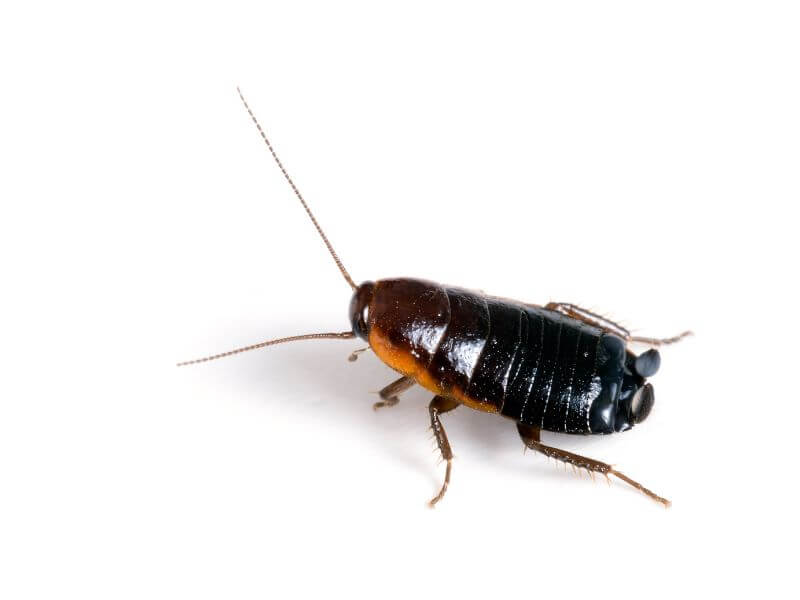
4. Oriental Cockroach (Blatta orientalis)
- Size: 20–25 mm
- Habitat: Damp, cool areas—basements, under sinks, and around drainage systems
- Key Features: Dark brown or black, with a shiny appearance
- Behavior: Less agile than other cockroach species but thrives in damp conditions, making it a common problem in older buildings.
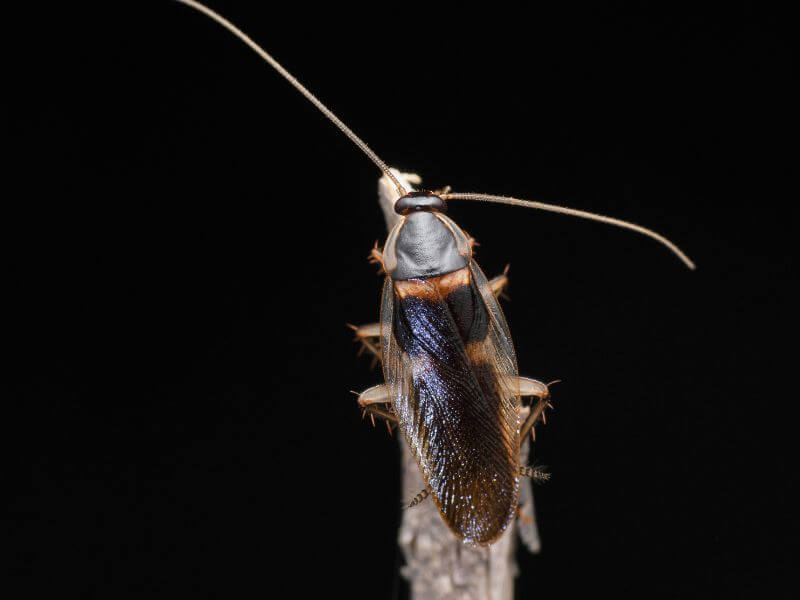
5. Brown-Banded Cockroach (Supella longipalpa)
- Size: 10–14 mm
- Habitat: Dry, warm environments—furniture, behind appliances, inside electrical equipment
- Key Features: Light brown with two distinct pale bands across the wings
- Behavior: Unlike most cockroaches, it prefers dry conditions and is often found inside furniture and ceilings rather than near water sources.
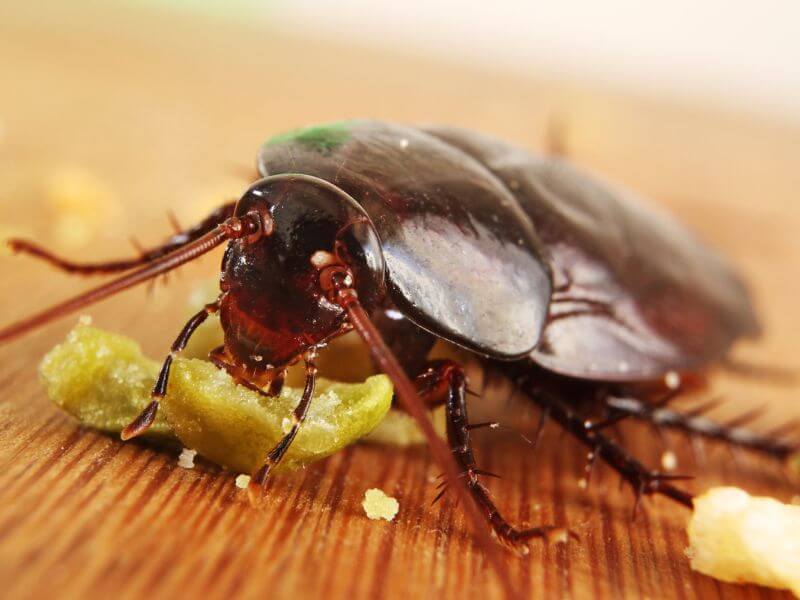
6. Smoky Brown Cockroach (Periplaneta fuliginosa)
- Size: 30–35 mm
- Habitat: Outdoor areas—gutters, gardens, garbage bins, and sheds
- Key Features: Dark brown, fully winged, and a strong flyer
- Behavior: Attracted to light and moisture, often flying into homes at night through open doors and windows.
Each of these cockroach species presents unique challenges. German cockroaches spread rapidly indoors, while Australian and American cockroaches invade homes from outside. Identifying the species is the first step in determining the right control methods.
Are Cockroaches Common in Australia?
Yes, cockroaches are widespread across Australia, thriving in the country’s warm and humid climate. These conditions provide the perfect environment for cockroach populations to grow, particularly in coastal and tropical regions. While some species, like the Australian cockroach, prefer outdoor habitats, others, such as the German cockroach, are well-adapted to indoor environments.
Cockroaches are found in both urban and rural areas. In cities, they infest homes, restaurants, warehouses, and commercial buildings, seeking out food, water, and shelter. In rural settings, they hide in gardens, sheds, woodpiles, and under decks, often making their way inside during warmer months.
These pests are nocturnal, meaning infestations can go unnoticed until numbers grow significantly. By the time cockroaches are seen during the day, there is often already a well-established colony. Signs of an infestation include droppings, egg cases, and an unpleasant musty odor.
Because cockroaches are highly adaptable and reproduce quickly, early detection and prevention are key to controlling their spread. Regular inspections, good hygiene, and sealing entry points can help keep infestations under control.
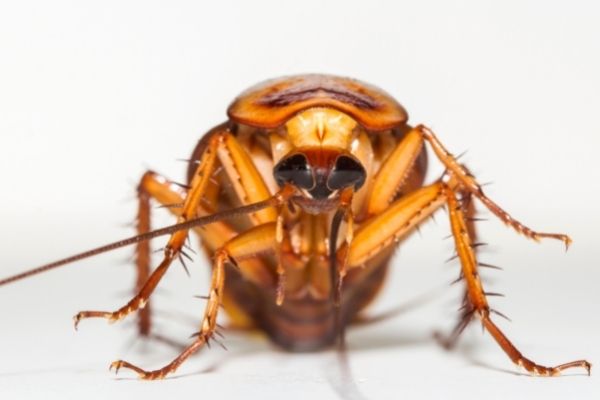
How Do I Get Rid of Cockroaches in My House in Australia?
Cockroaches are resilient pests that thrive in homes with food, moisture, and hiding spots. Once they establish a nest, they reproduce rapidly, making early prevention and control essential.
Early action is the best way to keep your home cockroach-free. If DIY methods aren’t enough, Coastwide Pest Control can provide expert solutions to eliminate infestations for good.
Here’s how to keep them out:
Are Australian Cockroaches Harmful to Humans?
While Australian cockroaches don’t bite or sting, they are significant carriers of bacteria and allergens, posing serious health risks. Like other cockroach species, they thrive in warm, damp environments and often move between drains, garbage areas, and kitchens, picking up and spreading harmful pathogens.
Disease Carriers
Cockroaches are known to carry bacteria such as Salmonella and E. coli, which can cause food poisoning, diarrhea, and stomach infections. They contaminate food and kitchen surfaces by crawling over them and leaving behind droppings, regurgitated food, and bacteria-laden footprints.
Allergy and Asthma Triggers
Cockroach droppings, shed skin, and saliva contain allergens that can trigger asthma and allergic reactions, especially in young children and those with respiratory conditions. These allergens can become airborne and settle into carpets, furniture, and bedding, making infestations a long-term health hazard.
A Major Hygiene Concern
While cockroaches don’t bite, their presence indicates poor sanitation or an underlying infestation issue. They reproduce quickly, meaning a few roaches can turn into a large infestation within weeks. Homes, restaurants, and businesses with cockroach problems risk food contamination, negative health impacts, and even legal consequences in commercial settings.
Prevention is Essential
Keeping food sealed, cleaning surfaces regularly, and eliminating water sources can help reduce the risk of cockroach infestations and the health risks they bring. For serious infestations, professional pest control is the most effective solution.
Where Do Australian Cockroaches Lay Eggs?
Female Australian cockroaches, like other cockroach species, lay eggs in protective cases called oothecae, each containing multiple eggs. These small, dark brown capsules are carefully placed in warm, dark, and undisturbed areas, where they can hatch safely.
Common Egg-Laying Spots:
- Behind kitchen appliances (fridges, ovens, microwaves)
- Inside cupboards, drawers, and pantries
- Under furniture and along skirting boards
- Inside cracks, crevices, and wall voids
- In sheds, garages, and storage areas
Reproductive Cycles & Infestation Risks
Australian cockroach eggs take weeks to hatch, but once nymphs emerge, they mature quickly. While Australian cockroaches don’t breed as aggressively as German cockroaches, their outdoor-to-indoor movement makes them a recurring problem.
Among all species, German cockroaches breed the fastest, with females producing up to 400 eggs in their lifetime. If left unchecked, an infestation can quickly escalate.
Breaking the Egg-Laying Cycle
Since cockroach eggs are hidden in hard-to-reach areas, DIY treatments often fail to eliminate future generations. Professional pest control is the most effective way to target egg cases, ensuring that adults, nymphs, and eggs are all eradicated.
Fun Facts About Australian Cockroaches
Cockroaches are one of the most resilient creatures on the planet, capable of surviving extreme conditions. Despite their adaptability, cockroaches remain a serious hygiene risk. If you spot them in your home, it’s best to take action immediately before their numbers multiply.
Here are some surprising facts about Australian cockroaches and their survival abilities:
- They can survive a month without food but only a week without water —moisture is essential for their survival.
- Cockroaches can live for up to a week without a head. They don’t rely on their mouth to breathe but eventually die from dehydration.
- As omnivores, cockroaches will eat almost anything, including food scraps, paper, glue, and even decaying organic matter.
- They can hold their breath for up to 40 minutes, allowing them to survive in drains, sewers, and even submerged environments.
- Even the cleanest homes can experience cockroach infestations, as these pests seek warmth and moisture. However, larger colonies tend to form in dirtier environments where food is more abundant.
Early action is the best way to keep your home cockroach-free. If DIY methods aren’t enough, Coastwide Pest Control can provide expert solutions to eliminate infestations for good.
Keep Your Home Cockroach-Free with Expert Pest Control
Cockroaches are a common problem in Australia, thriving in the country’s warm and humid climate. Whether they are breeding outdoors or invading homes and businesses, these pests can spread bacteria, trigger allergies, and contaminate food. Their ability to hide, reproduce quickly, and survive harsh conditions makes infestations difficult to control without proper intervention.
The best way to manage cockroach problems is through prevention, regular cleaning, and sealing entry points. However, once an infestation takes hold, DIY treatments are often not enough to eliminate them completely. Professional pest control ensures cockroaches, their eggs, and hidden colonies are fully eradicated.
At Coastwide Pest Control, we specialise in effective cockroach extermination, using targeted treatments to eliminate infestations and prevent future outbreaks. Don’t let cockroaches take over your home or business—book a professional pest inspection today and keep your property pest-free year-round!
